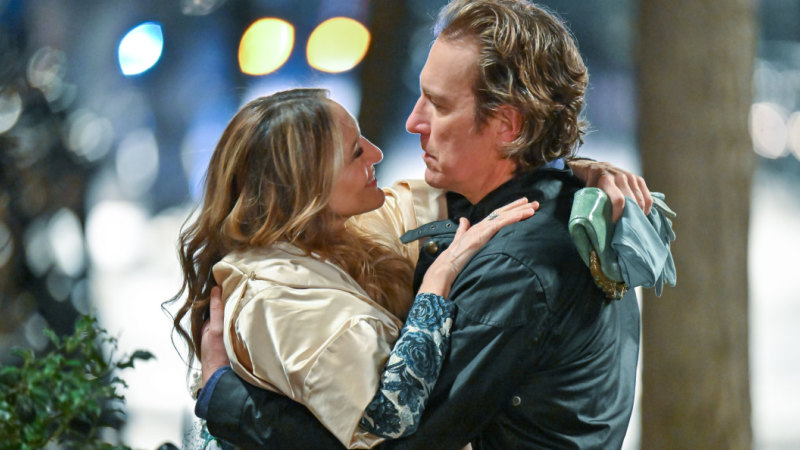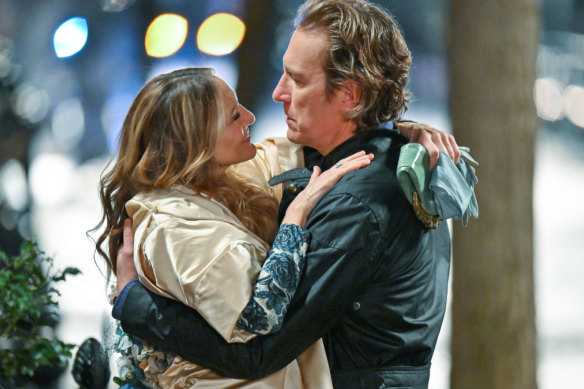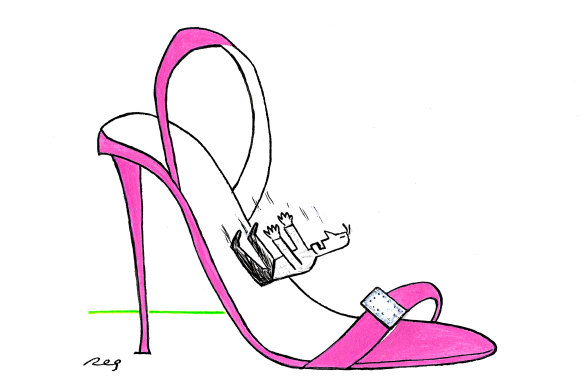Save articles for later
Add articles to your saved list and come back to them any time.
The interaction of the past with the present is the faultline on which great stories are built, sure. But many Sex and the City superfans were dismayed to learn, via the trailer for the second series of SATC’s sequel And Just Like That, that the show will recycle Carrie’s old boyfriend Aidan into her life.
Aidan Shaw was one of the two most important of Carrie’s love interests during the long-running show, the beta male in the love triangle he (unwittingly) participated in with Carrie and the horrendous Big.
Aidan is back, but is he a better man?Credit: HBO
Big was the alpha whose emotional avoidance was dressed up as mystery, a man so emotionally unavailable that Carrie never even felt entitled to use his real name (which turned out to be John – apt because Big/John was revealed to be decidedly average once Carrie finally captured him and they settled down).
Aidan was folksy and handsome, a carpenter who worked with his hands and wore lumberjack shirts without any apparent sense of irony. He loved his dog. He loved Carrie. He made a chair that she bought for her apartment. What could be so bad about that?
As many SATC scholars have elucidated since, Aidan didn’t really love Carrie just as she was. He hated her smoking. He hated her going out. He hated her attachment to her glamorous lifestyle. Had he even met Carrie? That’s all she was – a smoker with a glamorous lifestyle who enjoyed going out a lot.
Aidan hauled Carrie, the Manhattan denizen fuelled by Cosmopolitans and the New York Times Style section, into the woods to hang out at his bug-infested cabin. He trapped her into commitment by buying the apartment next door and knocking down the wall between them. She felt invaded. Was it any wonder she resumed the ciggies in secret and started an affair with the now-married Big?
Yes, Carrie was awful: neurotic, flighty, self-absorbed and terrible with money. But she was not as bad as the men she dated.
To commemorate the 25th anniversary of the iconic show – which was probably the biggest single cultural influence on women of a generation – Vanity Fair published an article titled “Who was the worst man on Sex and the City?”
It’s a close-fought contest. My vote would go to the horrid Jack Berger, a brooding wannabe literary novelist who went into a prolonged sulk when Carrie’s (non-literary and therefore inferior, in his eyes) book was published to great success.
Many of Carrie’s romantic trials involved men who were attracted to her success and independence but were threatened by it. Big at least let Carrie be Carrie. But even the bad men of Sex and the City all had something superficially attractive about them.
Illustration: Reg Lynch. Credit:
The annals of romantic comedy are full of unkempt and even oafish men who score hot babes – think the 2007 Judd Apatow film Knocked Up, in which a stoner slacker (played by Seth Rogen) wins over the successful and attractive Alison, after impregnating her during a one-night stand. Or Notting Hill, where the hopeless Hugh Grant character snags a movie star.
Woody Allen’s entire oeuvre (which has become tricky anyway, for other well-documented reasons I won’t delve into here) depends upon the premise that a beautiful, clever woman will be irresistibly drawn to a nebbish, prickly man who is deeply selfish, just because he cracks a few self-deprecating jokes and knows a lot about classic cinema.
Many sitcoms rely on the trope of a grumpy and/or hopeless husband who is adored by his efficient and attractive wife (my favourite episode of The Simpsons is where Marge snaps because she doesn’t get enough help around the house; she is sent away for a break to a spa called Rancho Relaxo. But Homer is so incompetent he loses baby Maggie while his wife is away and has to call a Missing Baby Hotline to locate her).
It has been a quarter-century since Sex and the City first aired, and it busted genres while creating its own. It has heavily influenced its successors – everything from the Millennial homage of Girls, to shows like Derry Girls, the delightful Irish comedy series about a group of teenagers, whose antics are set against the backdrop of Northern Ireland during the Troubles in the mid-1990s.
In the ensuing decades, the ideal male romantic lead has evolved somewhat. The recent bestselling book by cult American author Curtis Sittenfeld, Romantic Comedy, up-ends the trope of the “schlubby” male hero who lands the hot, eligible chick just by making her laugh.
The book asks why the opposite case is not often portrayed – why do we never see a frumpy-but-funny woman capturing the attention of a handsome, highly successful hero? (Although it must be said, Bridget Jones was a bit this person.)
It then goes on to explore that very scenario, with a male love interest who is hot, talented and famous, but also slightly insecure (he wears a wig). Our hero openly admits he is no match for the clever wit of our heroine, who has sub-Hollywood looks and is skittish around commitment.
The world’s most-read contemporary author, Colleen Hoover, who has barnstormed traditional publishing with her popular fiction, upturned the ideal of the male hero in her most famous book, It Ends With Us. The hero is introduced as dark, mercurial and emotionally elusive, but when the heroine finally lands him, she finds out the truth – he is prone to volcanic rages, and he hurts her when he’s in the grips of them.
In this story, the archetypal hero is a trap, and the heroine’s real struggle is to free herself. The heroines of 2023 crave freedom, and men who will give it to them. But romance still has a momentum of its own – Hoover wrote the sequel, It Starts With Us, because her fans wanted her to, and they specifically told her they wanted their heroine to fall in love again and stay there, this time.
Reader: she gave them what they wanted.
Jacqueline Maley is a columnist.
The Opinion newsletter is a weekly wrap of views that will challenge, champion and inform your own. Sign up here.
Most Viewed in Culture
From our partners
Source: Read Full Article


